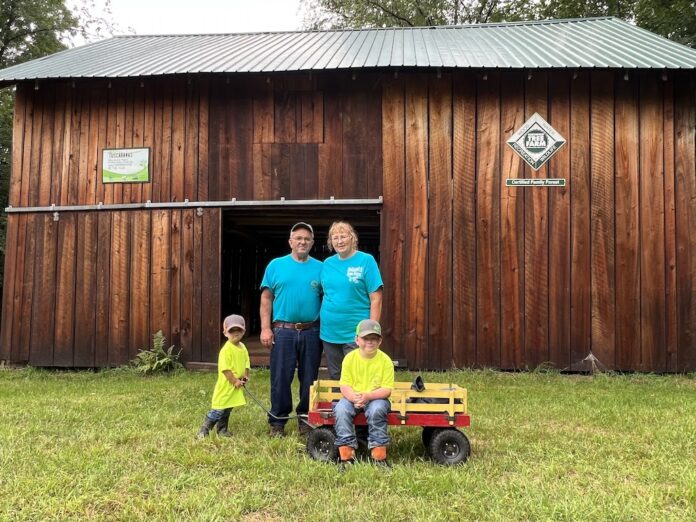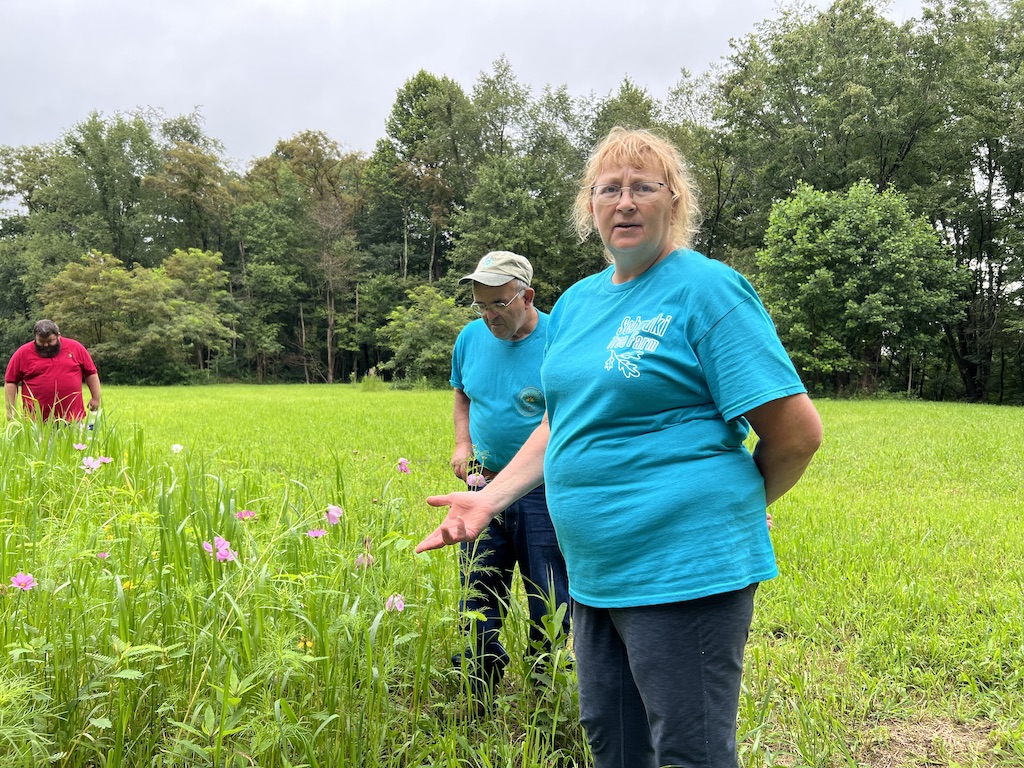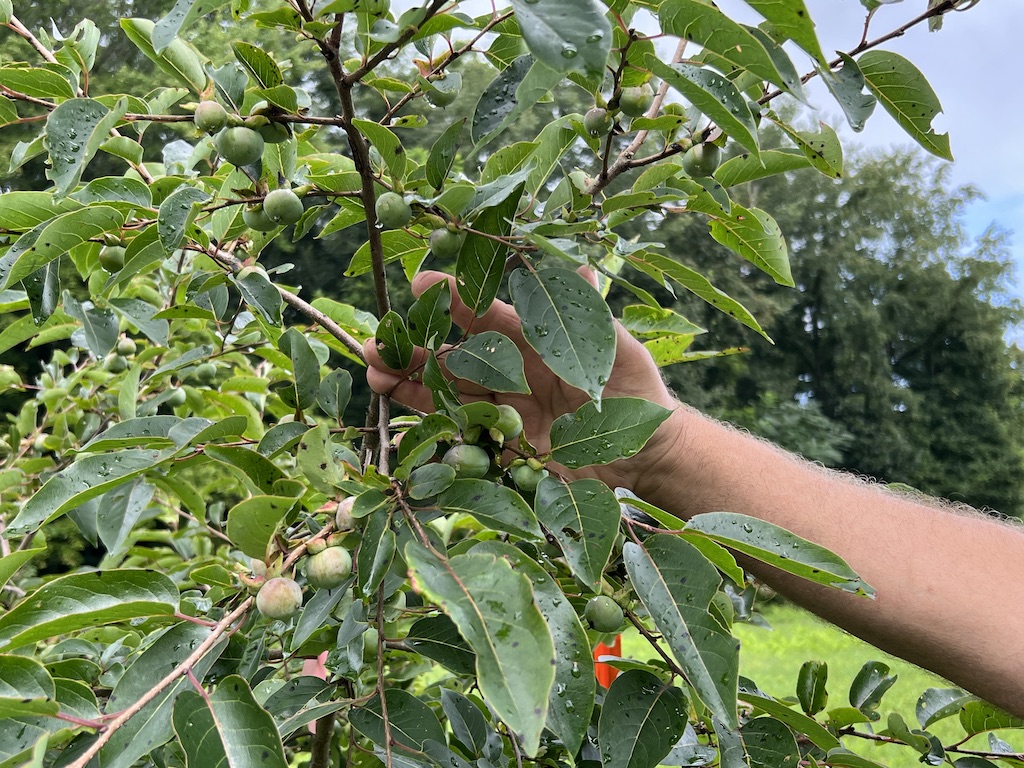
NEWCOMERSTOWN, Ohio — At 10 a.m. on a Thursday in August, Mike and Patsy Schmuki are done milking cows for the morning at their Stark County dairy farm. But they’re far from done with farm work for the day. They’re more than 40 miles south of the dairy farm, driving up a long, gravel road in Newcomerstown, to meet foresters at their tree farm.
Post Boy Tree Farm is more than a side project for the Schmukis. They started buying the land that makes up the 238-acre tree farm in 2001, and since then, they’ve been managing and planting trees there in addition to the woodlands at their Stark County farm.
“Being dairy farmers and managing the woodland too, and owning other land just to manage, is crazy,” said Luke Walters, an Ohio Department of Natural Resources state service forester who works with the Schmukis on their property. “Most only see it as an obstacle … it’s mind-blowing that they’re dairy farmers and they spend so much time and effort in the woods.”
This year, following a nomination from Walters, the Schmukis were recognized with the Ohio Tree Farm of the Year award. As they get ready to host the tree farm tour in September, the Schmukis are hoping to share some of what they’ve learned from foresters over the years with attendees.
“It seems like when everybody’s just timbering, they cut whatever,” Mike said. “There’s a correct way of doing things, and that’s what we hope they learn … That’s the whole purpose of field days, to show proper management, let people know there’s foresters around to work with them.”
Forestry
The Schmukis’ first experience with forestry was in 1994 on their dairy farm in Stark County. A sawmill nearby made them an offer to timber the woods on the farm. They were interested but wanted to get another opinion on their woods first. Patsy knew Koral and Randy Clum, who were both ODNR service foresters at the time, through her work with the Wayne Soil and Water District. Randy was the service forester for Stark County.
“I said ‘maybe we’d better have Randy come out here first,’” Patsy recalled.
Randy agreed it was time to timber some of the trees. Mike had assumed the best-looking trees would be marked for timbering. But Randy did the opposite.
“There’d be a perfectly straight one … he’d mark one that was leaning,” Mike said. “I was getting really frustrated.”
It wasn’t going well, so Randy decided to leave and come back another day.
“The second time he came back, right off the bat, he goes ‘This is like milking cows … you don’t sell your best cows; you keep your best cows. The best cows have the best heifers. If you want to get somewhere one day, that’s how you’ve got to do things,’” Mike said.
That explanation clicked for Mike. And they soon saw the results. First, the selectively marked and timbered trees wound up being worth more than the sawmill initially offered. And the next time they timbered years later, they were paid even more than the first time. That’s because the quality of their woodlands went up, Randy said.
“That’s like anything, the more you take care,” Randy explained. “It’s the same thing with the woods, but people just have a different concept of the woods.”

Farm
That experience is what got the Schmukis interested in forestry.
“We were kind of fascinated by it,” Mike said. So they started looking for more woodlands to buy.
It was hard to find large tracts of woodland for sale in Stark County, so they wound up buying land in Tuscarawas County. Over the years, they bought multiple adjacent plots that now make up the tree farm.
Most of the farm was already in woodlands, but about 40 acres of it had been strip mined. In 2008, they started planting trees, beginning with about 1,900 locust trees. That’s one of the few types of trees that will grow in strip mined soil. They also use locust trees for fence posts at the dairy farm.
Over the years, they’ve planted red and black oak, maples and more. But oak trees are the Schmukis’ main goal.
“It seems like every year we plant something different, just to see how they do,” Mike said.
Currently at the dairy farm, they milk about 100 Holsteins, raise close to the same number of heifers, have 29 Angus brood cows and raise as much of their own hay and corn as they can. They go down to the tree farm in the middle of the day, so they can finish the morning milking and make it back in time for the evening milking. When their four children were younger, Mike would stay at the tree farm for longer with a couple of the kids, and the others would stay at the dairy farm and help Patsy milk.
“We got more done when we were young and ambitious and the kids were here,” Patsy said.
Now, one of their children, Kenney, still farms with them while the other three have pursued careers outside of farming.

Management
The Schmukis continue to work with Koral and Randy, both now retired foresters, and ODNR state service foresters on their land. They’ve planted pollinator plots, had food plots for wildlife added to the property and worked on managing invasive species. A lot of the work the Schmukis do in their woods is “managing sunlight.”
“We’re cutting down trees. We’re putting the sunlight and the growth on the trees that we think are the better trees,” said Koral Clum.
They haven’t truly timbered the property yet. The trees, and the woods as a whole, haven’t been quite ready so far.
“We’re trying to grow the best quality trees that we can and the most per acre that we can,” Mike said.
By getting invasive species under control first, they’re making sure that those plants won’t take over when they do timber. The Schmukis have used federal programs, like the Natural Resources Conservation Service’s Environmental Quality Incentives Program, to help with things including tree planting, brush management and invasive species management. They have also held field days at the farm to share some of what they’ve learned.

Award
Walters decided to nominate the Schmukis for the Ohio Tree Farm of the Year after speaking at a field day the farm hosted in September 2022. Work with the East Central Ohio Forestry Association and field days were a big part of why the Schmukis won the award, Walters said, but it was also “just the hard work they’ve done.”
The award recognizes farms certified by the American Tree Farm System, and its core values are wood, water, recreation and wildlife, Walters said. The organization also puts a big emphasis on family-owned woodlands. The Schmukis exemplify that idea, Walters said. Several of their children have been to forestry camp. Their grandchildren often come down to the tree farm with them.
“They bring that to life,” Walters said.









